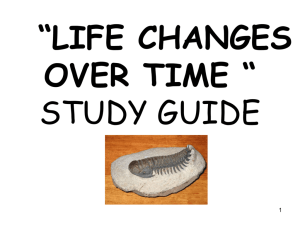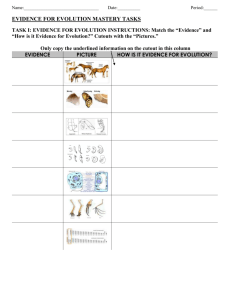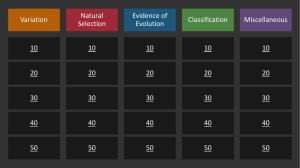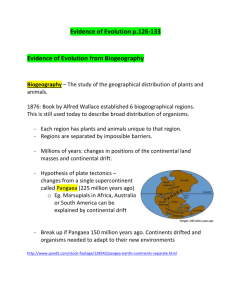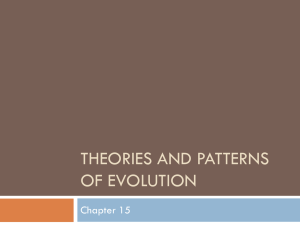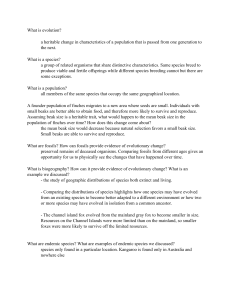Evidence of Evolution
advertisement
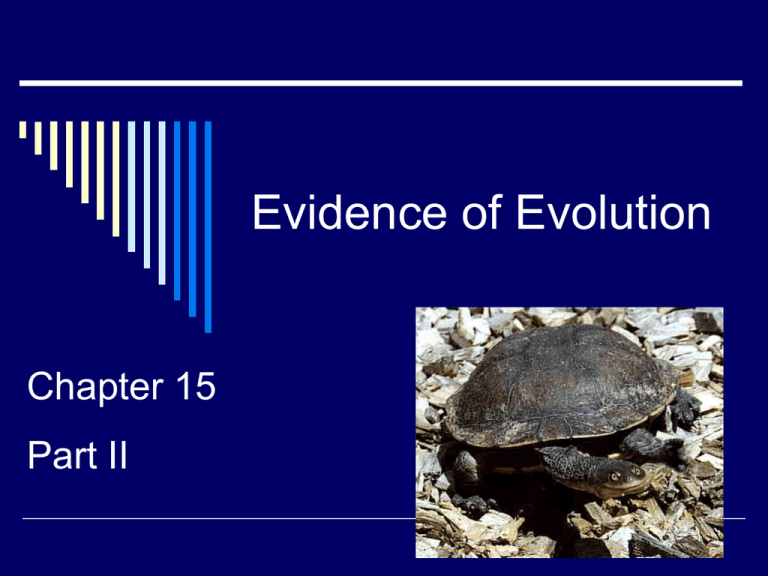
Evidence of Evolution Chapter 15 Part II 1. Fossil Record Are able to observe links between modern forms and ancestors (ex. transition species) Relative age- age compared to other fossils by referring to the geologic time scale and records of known fossils Absolute age- use of radiometric dating to date rocks 2. Biogeography Geographical distribution of species New organisms arise in same geographic area where similar forms already lived Example) Australia – has native wolves, cats, mice, moles, and anteaters. Most mammals are marsupials (animals evolved in isolation) Ex) Ancient Irish Elk Ex) European Elk 3. Anatomy and Embryology Homologous structures- anatomical structures that occur in different species that originated in most recent common ancestor may have different functions but look similar Common Ancestor: Human Bat Analogous Structuresa body part similar in function to another organism due to environmental pressures Ex) the wings of a fly, a moth, and a bird developed independently as adaptations to a common function – flying Analogy vs. Homology Vestigial structures- a part of an organism with little or no function but which had a function in an ancestral species Comparative Embryology- Study of structures that appear during embryonic development Ex)All vertebrate embryos go though a stage in which they have gill pouches on the sides of their throats 4. Molecular Biology (DNA and Proteins) Comparison of DNA, RNA, and amino acid sequences Greater the number of similarities, the more closely the species are related through a common ancestor Shows the common descent of the most diverse organisms. Amino Acid Chart Evidence of Evolution: fossil evidence, homologous structures, embryology, vestigial organs, biochemical Bones in bird’s wing and human’s arm are similar in structure. All organisms use ATP to transfer energy. There are similarities in structure among the early stages of fish, birds and humans. Humans, unlike rabbits, have no known use for their appendix. Horses have increased in size and decreased in number of toes since the Eocene. Phylogeny The relationships by ancestry among groups of organism Represented by the “Tree of Life” Different evidence supports different “trees” Patterns of Evolution 1. Coevolution 2. Convergent Evolution 3. Divergent Evolution 1. Coevolution When two or more species have evolved adaptations that influence each other (evolutionary “arms race”) Examples: Predator-prey Parasite-host Plant-animal pollinator (bee and flower) Humans have developed and used antibiotics to kill bacteria, bacteria have evolved to become antibiotic resistant 2. Convergent Evolution Organisms appear to be similar but are not closely related at all The environment selects similar traits Result in analagous structures Ex) dolphin and shark 3. Divergent Evolution Two or more biological characteristics become more and more dissimilar in response to different habitats Adaptive radiation- a new population in a new environment (island) will undergo evolution until the population fills many parts of the environment Ex) Galapagos finches Caribbean Anole Lizards Artificial Selection The intentional breeding (by humans) of certain traits, or combination of traits, over others


